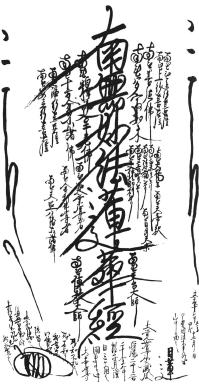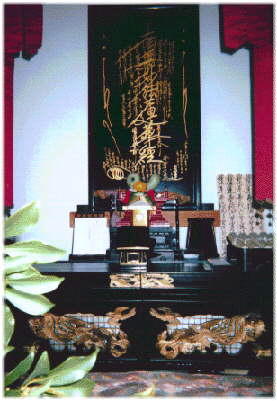Both the Lotus Sutra and the Bible offers salvation through faith.
A bit of background on the Bible before we make the comparison:
An essential teaching of Christianity is the concept of the eternal damnation of the non-believers. The Gospel of Mark 9:43 talks of a fire that can not be put out. Thessalonians 1:8-10 describes a deity of fiery vengence and the eternal loss of those who fail to accept Christianity. Mark 16:16 talks about how the baptized will be saved while those who aren't will be condemned. Equally as important, the Bible specifically excludes certain people from salvation, even if they humbly repent. The Gospels according to Mathew 12:31-32, Mark 3:28-30 and Luke 12:10 teach that those who commit the so-called Sin against the Holy Spirit are guilty of an unforgiving sin and may never hope for salvation.
In Hebrews 6:4-8/12:17/10:26-30 we see that no one commiting apostacy (abandonment or defection) of the christian faith can ever hope to gain salvation even, as in the case of Esau in the Old Testament(Genesis) who regrets his desision, is forever cast aside. Many modern day christians have attempted to "interpret" these passges in a more compassionate and gentle light using clever words and arguments, but the "inspired" words of the Bible remains for all to see and read for themselves. Also, at the whim of their deity one is either doomed or saved. One who is doomed by this merciless deity is Pharoah(Romans 9:17-18 citing Exodus 9:16.), Here, the purport of this deity appears to be to demonstrate his sovereign power. Thessalonians 2:11-12 teaches that this god in full awareness makes people believe falsely, in order to condemn them. They are condemned, not temporarily, as a means of teaching or to correct their misguided belief, but rather on a whim to demonstrate his power and to an eternal unremitting hell. Analagously, Romans 9:20-21 states that we should not question the will of god as we are merely clay for the potter. Christianity is so exclusionary! "for many are called, but few are chosen." (Mathew 22:14) Corinthians 9:22 tells the story of Paul of Tarsus. He saves some people but not others and is quite discriminating of who he saves through his many guises.
To those saved by Christianity it smells like sweet perfume, to those condemned it smells like raw sewage. Those who meet Jesus and the Christians and by predestination do not believe are only confirming their own ruination(Corinthians 2:15-16).
The habitual manifestation of vengence characterizes the Jewish as well as the Christian god. This god acts to cause irrevocable and terrible punishment and the very conclusion of the entire Jewish scripture (Isaiah 66:24) is the revelation of Yahweh(the enemies will be displayed in eternal fire and worms in his antechamber.) Mark 9:48 is the Christian equivalent.
The Lotus sutra, the culmination of the Buddha's wisdom states:
"Of those that hear this Dharma there is not one that does not attain Buddhahood" (Lotus Sutra Chapter 2, Tactfullness)
"In a future era If there are good son's or good daughters who hear the "Chapter of Devedatta" of the Myohokkekyo and with a pure mind believes and reverences, not producing doubts and confusion, they shalll not fall to the hells, hungry ghosts, or beasts but be born with the Buddhas of the Ten directions and in the place where they are born they shall constantly hear this sutra; If they are born among humans or gods they shall receive superior and sublime joy.(ibid. Chapter 12, Devedatta)
These two passages are quite clear on the future of those who either merely just hear the Lotus Sutra or of those who pureheartedly believe.
Now, lets turn to those who do not believe. There are passages in the Hokkekyo which teach of the of the terrible punishment of those who fail to believe and of the worst of all the hells, Avici hell, for those who slander the Sutra or the Sutra's adherents. These passages are found in the 3rd Chapter(Parable), the 10th Chapter (Teacher of the Law) and the 20th Chapter (Bodhisattva Never Despise). Despite the superficial similarites to the Christian hell, not even the worst hell (mugen jigoku), Avici, is eternal. True, it is unremitting while in this realm, but one will without doubt reemerge. Therefore, all the Buddhist hells are at worst equivalent to Christian purgatories.
".... they received great agonies; having ended their punishment, they again met the Bodhisattva Jofukyo (Fukyo) teaching and converting to Supreme Enlightenment."(Chapter 20)
Nichiren affirms too, that those who persecute him will fall into the Avici hell but then will become his disciples and attain Buddhahood. Redemption will come to even those who oppose the Lotus Sutra. What a grand and awe inspiring vision the Buddha paints in this, the summit of his fifty years of preaching!
These teachings are of sublime significance in the context of the entire Buddhist canon, particularly of the Mahayana. Only the Hokkekyo allows the practitioner to fulfill the first of the Four Great Vows of the Bodhisattva (vows which all Bodhisattvas on their spiritual path have promissed to uphold): "beings are innumerable: I vow to save them all." The Buddhism as taught in the other sutras does not enable the practitioner to realize this vow because all of these sutra exclude, in one way or another, one or another class of beings. Some of these sutras exclude those of the Two Vehicles of Hinayana, others exclude evildoers, others those of incorrigeable disbelief (icchantikas), and others women. Even Amida in the Pure Land Sutras (Muryoju Sutra in particular), the so-called savior of the evil people of our age, excludes slanderers of the Dharma or those who commit the five cardinal sins. The Fugen Sutra, the concluding sutra of the Lotus sutra, affirms that the very subjects of the salvation of the Lotus Sutra are blasphemers and those who commit the five cardinal sins. The Lotus Sutra (and the Hikekyo or Flower of Compassion Sutra)) teaches that it is Shakyamuni Buddha who in a former life vowed to accept the beings rejected by the other Pure Lands of the ten directions declaring, "I alone can save them" (Chapter of the Parable).
Christianity, as a religeon that rejects certain sinners, is even more noticeable than those of the provisional sutras of Buddhism, let alone the Lotus Sutra. As seen in the first post above, not only are those who reject Christianity but also those who fall away and even those who utter a single word against the "Holy spirit". not able to achieve salvation but are doomed to eternal damnation. Even though John 3:17 declaresgods intention to save all, the Bible adds an exclusionary clause for unbelievers(John 3:18) which says they are condemned.
The "worst case scenario" is a very useful concept in comparing and contrasting Buddhism and Christianity. Therefore, the comparison between the cases of Devedatta and Judas Iscariot is most instructive. Both of these men represent the epitomy of evil, not only in the sense of worldly evil but more importantly, in the sense of spiritual evil. This evil that pits itself against the very root of salvation itself, the very source figure of salvation in their respective traditions (Christ in Christianity and the Buddha in Buddhism). Devedatta attempts to kill the Buddha and corrupts the morals of King Ajatashatru (Buddhism's rough equivalent to Oedipus. He kills his father, marries his mother, and also attempts to kill the Buddha). Devedatta then fakes his repentance while again planning to murder the Buddha. Judas, possessed by the devil, betrays Jesus leading to Jesus crucifixtion and murder. Devedatta, it is taught, ends up falling into a crevice during an earthquake while Judas is said to have either committed suicide or bursted open (Matthew 27:5 Acts 1:17-18). The ensuing spiritual fates of the two are very different, however.
Judas is destined from the start to be lost.(John 17:12). He is to be condemned before he even acts, "that it would have been better for him never to have been born" even though he later feels remorse. This concept in Christianity is known as meta-melomei (Mathew 27:3). He is predestined "beforehand he is made to do what he does" (John 13:21-30) and his horrendous fate is declared in Mark 14:21, Luke 22:21-22 and Matthew 26:24-25. Again, using clever and disengenuous reasoning, some Christians state that he is really saved by the famous Biblical prayer of Jesus to forgive those who no not what they are doing (Luke 23:24). This is absurd because Judas knew very well the teaching of Jesus and knew perfectly well what he was doing.
As far as Devedatta is concerned. despite his evil and insufferible punishment, we see that Devedatta is promised to attain Supreme Enlightenment as the Tathagata Tenno(Devaraja). Judas is never summoned back in the Christian scriptures and is doomed to hell eternal. Devedatta, the avowed enemy of the Buddha who was well versed in the entire Buddhist Canon (as was Judas in the Christian teachings), and abandoned for more than forty years by every sutra, in the Lotus Sutra, is "summoned back" to become a Buddha.
There is a rational concept in the Buddhism, ko itsu rei sho (mentioning one to illustrate all). This is applicable to this WORST case in Buddhism, that of Devedatta. Since Devedatta has attained (or will attain) to Supreme Enlightenment, matricidal and patricidal murderers, blasphemers, unbelievers, etc. will attain to emancipation by the teaching of the Lotus Sutra let alone us ordinary rabble. In the Lotus Sutra, both slander (unbelief) and belief (in Namu myohho renge kyo) both plant the seeds of Buddhahood. A Sutra passage (?) cited by Chan-jan in referring to the unbounded merit of the Lotus Sutra states, "Hearing the Dharma, bringing forth irreverence and contempt and falling into hell are superior to making offerings to Buddhas numbered as the sands of the Ganges." He goes on to state that one may make an offering to a Buddha without so much as hearing a lesser teaching let alone the Hokkekyo but merely having heard this supreme teaching one will surely attain Buddhahood even if one slanders it.
Who is most in need of salvation, which being or class of beings: the ones who readily accept and embrace the path to "redemption" or those who resist, refuse, are perverse or refractory? To put it another way, who is more in need of salvation those who are inclined to good or those who are inclined to evil? Which religeon abandons the incorrigeable disbeliever and wrongdoer? Which religeon saves the most worthless, corrupt and cowardly? Which religeon truly "forgives" its worst enemies?





